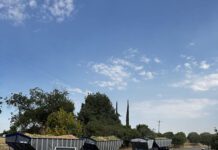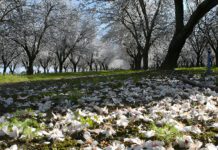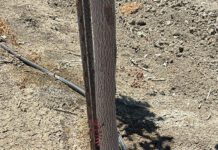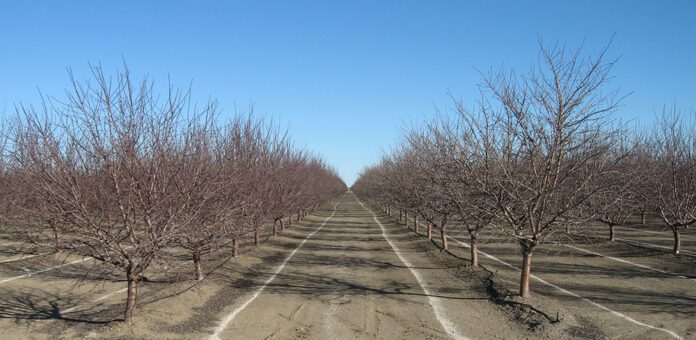
Nutrient applications are one of the most important things that can be done for an almond or pistachio orchard, according to Phoebe Gordon, UCCE orchard systems advisor for Madera and Merced counties, and postharvest applications also set the stage for tree health and production the next season and beyond. These nutrients might include nitrogen, potassium, boron and zinc, although growers, consultants and researchers are fine tuning postharvest recommendations.
Is Nitrogen Needed?
Gordon said a lot of growers are still in a habit of making postharvest N applications.
“In the past, we did suggest in almonds that you should save 20% of your nitrogen (N) for postharvest. We don’t really think it’s necessarily a good idea anymore unless your July tissue samples show that your trees are deficient,” she said, especially with an early harvesting variety.
But with a late-harvesting variety like Monterey that harvests in late September, and some years even early October, or if trees are stressed and the leaves are yellowing and falling off, Gordon suggests timing N in the spring when the trees are actively taking it up.
In pistachio, there’s never been much evidence of N uptake after harvest, Gordon said. “My colleague, Doug Amaral in Kings County, was looking at nitrogen uptake patterns in Golden hills and Lost Hills pistachio varieties. He confirmed there’s not really any nitrogen uptake postharvest, so for pistachios especially, apply nitrogen before harvest.
“If for some reason you fall behind on your nitrogen applications, maybe you can apply just after harvest, but again, if the trees are super stressed, or there was a late harvest, just wait until next year for your nitrogen applications,” Gordon said.
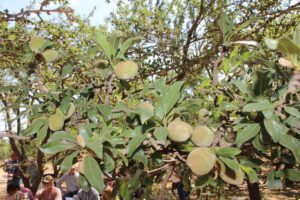
Potassium Strategies
Strategies for potassium (K) fertilization are different than N. “One strategy with potassium is to fertigate throughout the growing season, like you would nitrogen and aim to get your annual potassium requirement on during fruit development. Traditionally, potassium has been banded on in the fall, and the winter rains push that nutrient in the soil. There are still some folks I know who successfully do that,” Gordon said.
Growers are moving away from banding K because it’s expensive to do these applications instead of running it through the drip system. But banding is still a valid application, Gordon continued. It just has to be banded within the wetting zone of whatever irrigation system is used.
K-fixing soil isn’t uncommon on the east side of the San Joaquin Valley. This is a soil that K will actually get trapped in clay particles. It can still be banded, but it needs a really heavy application rate to saturate those fixation capabilities and have K left over, Gordon said.
“In those soils, it might just be better just to fertigate during the growing season,” Gordon said.
“And you don’t need to worry about leaching potassium because for the most part it sticks around in soils. If you have a really sandy soil, it might move a little bit, but you don’t have to worry about it leaching from the soil during wintertime unlike nitrogen,” she added.
“Pistachios have ‘on’ and ‘off’ years. In on years they might take up some potassium postharvest, but most people band their potassium too late to meet those needs, so I wouldn’t necessarily recommend trying to time your fall bands for that small postharvest potassium uptake It also takes time for fertilizer to dissolve and move into the soil. But it’s not a bad idea just to make sure you have potassium available in your soil postharvest with pistachios,” Gordon said, adding she’s encountered K deficiencies but never seen N deficiencies.
“Potassium absolutely affects yield, but if your trees are sufficient and you’re looking to cut costs, you’re not really going to suffer in the short term if you skip next year or apply less. I might suggest, if you’re going to cut back on the potassium, you fertigate it during the growing season to make sure it is delivered directly to the root zone,” Gordon said.
“But,” Gordon cautioned, “over time, the trees will become depleted if you’re not replacing what was lost.”
This will result in a long-term decline in yield, and it will take time for the trees to recover. It’s a situation where a grower may save money now, but depending on how severe and how long the cutback is, it will take work to rebuild the orchard in the future.
“I’m not the one who’s writing the checks and balancing the accounts, so this is something that growers are going to have to make their own decision on. But if you’re cutting back or limiting potassium applications, you’re going to eventually see effects on yield in your orchard,” Gordon said.
Is there a benefit of banding over fertigation? “No, but I think that banding is just a very, very old application method,” Gordon said, adding when doing a banded application, it has to be placed within the wetted zone.
“Past research looking at fertigation versus surface applications of potassium fertilizer showed fertigation moved the potassium farther laterally in the soil, but when the researchers made a heavy application on the soil surface, potassium did move down into the root zone,” Gordon said.
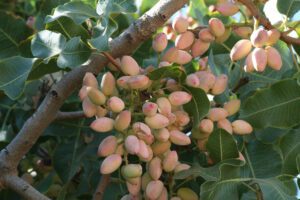
Boron Differences
Boron (B) is different between almonds and pistachios because it is mobile in almond and immobile in pistachio, which means it ends up in the fruit in almond and in the leaves in pistachio. B, like N and K, is important for yield.
“Boron is really critical for yield because it’s important for successful fertilization of the flower,” Gordon said.
“Because it’s immobile in pistachios, if a foliar spray is done after harvest, it will land on the leaves, it might be absorbed by the leaves, but will not be distributed to other parts of the plant, so boron is better applied as a foliar spray in the spring for pistachios,” Gordon said.
“Fall sprays of boron have been very effective in almonds,” Gordon continued.
There is an excess of B in certain areas of California like the west side of the San Joaquin Valley. In those cases, a B application is not recommended for almond if the hull values are approaching toxicity. If it’s not at toxicity level, a B application can be a good idea to ensure ideal levels, Gordon said.
Gordon recommends testing B levels before making applications. “I will say out of all the nutrients that are required in California, I have most often seen boron deficiencies for both almonds and pistachios. That’s on the east side of the San Joaquin Valley, very sandy soils, surface water and well water are both low on boron,” Gordon said, so testing almond hulls as close to harvest as possible is advised.
With pistachio, B ends up in the leaves, so it’s recommended to test the leaves for boron, Gordon said.
“In general, I think it’s a good idea just to get a hull analysis for almonds. Given how closely connected to yield boron is, I think it’s an inexpensive input to ensure you’re not losing out on yield,” Gordon said.
Zinc for Almond
Gordon said Zinc (Zn) can be applied in the fall for almond but not pistachio. “It should be applied in the spring for pistachios, and it can be applied during the spring for almonds, too.
“Zinc has been shown to have limited mobility in Prunus species if applied during the fall as a foliar spray. I find most folks I talk to do spring sprays, but a fall spray can be done, too.
“Testing for zinc is tough with any metal micronutrient-containing spray applied on the leaves because some of it actually becomes bound to the leaf cuticle. If you do a foliar spray on your trees, you’re going to see really high levels of zinc because it’s on the leaves. I think the reality is if you do foliar spray at the right time, your trees probably aren’t going to be deficient. You might have to do it every single year, but within that growing season, they’re probably not going to be deficient,” Gordon said.
“Keeping an eye out for zinc deficiency symptoms is always a good idea, but it’s just a tough one because once you see symptoms, you’re affecting growth and yield. I know folks that just spray zinc because they can throw it in the tank with other things,” Gordon said.
In conclusion, Gordon said, “For almonds, make sure you don’t stress out the trees too much postharvest. Research on deficit irrigation shows really severe cutbacks in water after harvest could reduce bloom the following year. I also like to see folks do soil testing at the end of the year just to see what the salinity levels are. It’s always a good idea to kind of have an idea what’s going on your soil.”







